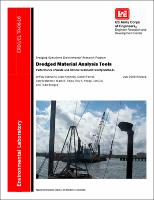Please use this identifier to cite or link to this item:
https://hdl.handle.net/11681/6880| Title: | Dredged material analysis tools : performance of acute and chronic sediment toxicity methods |
| Authors: | Steevens, Jeffery A. Kennedy, Alan James, 1976- Farrar, J. Daniel Reiss, Mark R. Kropp, Roy K. Bridges, Todd S. McNemar, Cory Doi, Jon |
| Keywords: | Amphipoda Water quality biological assessment Polychaeta Marine sediments Dredging Operations and Environmental Research Program (U.S.) |
| Publisher: | Engineer Research and Development Center (U.S.) |
| Series/Report no.: | Technical Report (Engineer Research and Development Center (U.S.)) ; no. ERDC/EL TR-08-16 |
| Abstract: | This report and research were supported by the U.S. Army Corps of Engineers New York District and U.S. Environmental Protection Agency Region 2. The work was conducted to provide insight into the potential advantages and disadvantages of using chronic sediment toxicity tests with relevant benthic macroinvertebrates as part of dredged material evaluations, as described in the Inland and Ocean Testing Manuals (USEPA/USACE 1991, 1998). Nine sediments collected from the New York Harbor (NYH) were used to assess test methods in a preliminary evaluation at one test facility and an interlaboratory evaluation at three test facilities. The two acute test methods (10-day Ampelisca abdita and Americamysis bahia) currently used in evaluations of NYH material were compared to available chronic protocols to gauge relative performance of the toxicity tests. Acute tests are typically short-term (e.g., 10-day) lethality assessments conducted over a small portion of the test organism’s life cycle, while chronic tests are longer-term and assess sublethal measurement endpoints (e.g., growth and reproduction) in addition to lethality. The available chronic test methods used in this study were the 28-day test using the estuarine amphipod, Leptocheirus plumulosus, and 20-day and 28-day tests using the marine polychaete Neanthes arenaceodentata. Use of chronic tests is recommended or required by dredged material evaluation guidance and regulations, respectively. The sublethal endpoints measured in chronic tests may be more sensitive measures of toxicity and more predictive of longer-term population effects. Of the tests compared, the currently used acute (10-day) Ampelisca abdita test and the available chronic (28-day) L. plumulosus test were the most responsive (i.e., sensitive) to the tested NYH sediments. Response is defined as the amount an endpoint (e.g., survival) was reduced for test organisms in site sediments relative to that same endpoint in the control sediment. Of these two test methods, neither clearly demonstrated better capability to identify contaminated sediments (i.e., “hits”). The A. abdita test was more consistent in performance and exhibited greater statistical power but demonstrated lesser response to the sediments and lower correlation with sediment chemistry. The sublethal endpoints used in the L. plumulosus test were more responsive to the sediments and more closely related to sediment contamination but had lower statistical power than lethality endpoints. An acute (10-day) test using L. plumulosus was also conducted in one laboratory and similar responsiveness was found relative to the acute A. abdita test. The remaining toxicity tests, including the currently applied acute A. bahia test and the 28-day N. arenaceodentata test were not responsive to the tested sediments in this evaluation and thus did not suggest toxicity in any of the tested sediments. Specific conclusions and recommendations on the application of these test methods are offered at the end of this document. |
| Description: | Technical Report |
| Gov't Doc #: | ERDC/EL TR-08-16 |
| Rights: | Approved for Public Release; Distribution is Unlimited |
| URI: | http://hdl.handle.net/11681/6880 |
| Appears in Collections: | Technical Report Technical Report |
Files in This Item:
| File | Description | Size | Format | |
|---|---|---|---|---|
| ERDC-EL TR-08-16.pdf | ERDC/EL TR-08-16 | 1.15 MB | Adobe PDF |  View/Open |